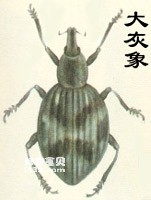This species and the Mongolian gray weevil are the two main weevils that damage apple seedlings. The distribution is very common, the feeding habits are mixed, and it damages many kinds of plants such as cotton, hemp, sugar beet, beans, melons, apples, pears, forest seedlings and so on. Both weevils damage apple leaves as adults. The damaged leaves show circular or semicircular nicks, affecting the growth of seedlings.

Body length 9.5-12 mm, body gray-yellow or gray-black. The head tube is thick and wide, with three longitudinal grooves on the surface and a black groove in the center. There are longitudinal grooves on the wing elytra and obvious short vertical brown stripes.
Life history and habits: Also known as the big gray weevil, commonly known as the gray weevil. One generation occurs every year, and the adults spend the winter in the soil. They become active in April of the following year, climbing onto fruit tree seedlings and damaging new buds and leaves. Eggs are laid in June. The eggs are laid on the tips of the leaves, and the tips of the leaves are folded from both sides, and the eggs are wrapped in the folded leaves. After hatching, the larvae fall to the ground and burrow into the soil to live, pupate in the soil, and emerge as adults for the winter. Adult insects cannot fly, can only crawl, and move slowly. They are not active during the day and are most active in the early morning and evening for feeding.
animal tags:
We created this article in conjunction with AI technology, then made sure it was fact-checked and edited by a Animals Top editor.